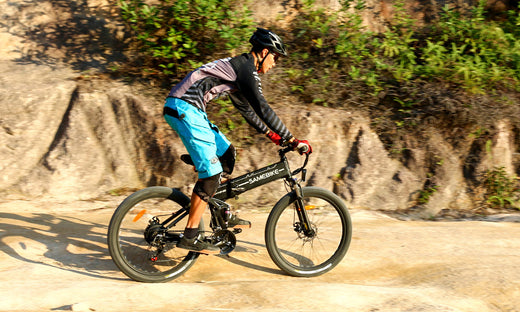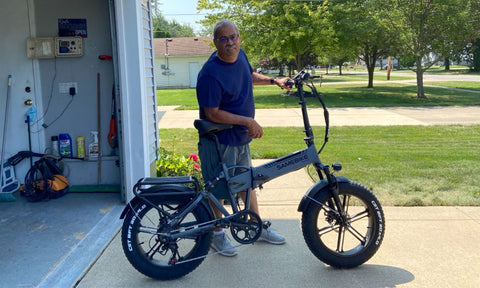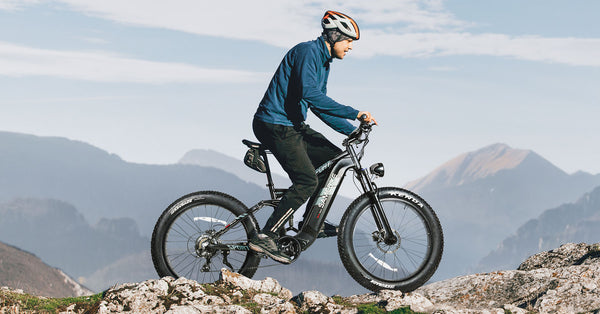Torque Vs. Cadence: How to Choose the Right Bike Sensor?
The pedal assist sensor can automatically turn on the motor eliminating the need to use a throttle. This makes e-bikes more efficient and easier to use. The pedal assist sensor also measures the e-bike's speed and signals the e-bike's PAS how much power is needed to propel the e-bike forward.
So, how do sensors work? Generally, when you drive your e-bike, the sensor transmits the signal to the pedal assist system (PAS). The PAS then communicates the information to the bike's control unit.
Depending on your e-bike, it can use either a torque or a cadence sensor. These two sensor types offer different features and benefits that are definitely worth knowing for every e-bike user. In this article, we will compare these sensors and help you decide which one is fit for your preference and needs. Let's get into it!

Torque Sensor
A torque sensor is equipped with a precise strain gauge that determines and measures the force you exert on the pedal. As you pedal, the gauge measures how hard you pedal and sends a signal to the e-bike's control system. When the signal is received, the system calculates how much electric power should the motor supply to keep the e-bike running.
Essentially, the harder you pedal, the more power the motor releases. On the other hand, if you pedal a lighter, lesser output power is generated. If you stop pedaling, the sensor also signals the control system and stops the supply of power. It allows the e-bike to adjust the pedaling power as it fluctuates in a very short period of time.
Moreover, a torque sensor can intensify the pedal input to generate an equivalent output. Different e-bikes have varying pedal assist settings and features. However, typically, the lower setting, or the eco-mode, may boost the pedaling force by up to 50%. On the other hand, the highest setting, or the performance mode, can increase the pedaling force by 300%.

Pros of a Torque Sensor
- Automatically adjusts the motor's power based on the pedal pressure allowing a more natural riding experience.
- Eliminates unexpected power jolts when the pedal pressure increases or decreases.
- Efficient pedal assistance that triples your capacity and provides a higher range.
- Enables long-battery power by using the pedal force from the rider.
Cons of a Torque Sensor
- Only allows you to achieve top speed when you exert more pedal pressure.
- Expensive purchase price
- Requires more effort to use as you will have to provide pedaling force to keep the motor moving.
Cadence Sensor
Unlike a torque sensor, a cadence sensor has a sensor and a series of magnets. The sensor is usually attached to the e-bike's frames near the bottom bracket while the magnets are connected to a disc mount on the crank.
When you start pedaling the magnets move and send a signal to the sensor. This is how the sensor knows that the e-bike is moving and in need of motor power. Similarly, when you stop, the magnets also stop moving. This gives the sensor the knowledge that the e-bike is not moving anymore and will eventually signal the e-bike's control unit to turn off the motor.

Depending on the cadence sensor model or type, it can have 3 to 14 magnets in the disc. Essentially, the more magnets there are, the more responsive the pedal assistant is. This is because the control unit of the e-bike receives signals more frequently when there are more magnets. Contrastingly, if there are lesser magnets, the pedal assist may not be that responsive and efficient.
Typically, e-bikes equipped with this sensor have a switch that automatically turns on the motor when you start pedaling forward and turns it off when you stop. They also require you to control the boost level and speed by adjusting the assist mode or settings.
When you pedal forward, the sensor sends a signal to the e-bike's control unit. When the signal reaches the control unit, it automatically turns on the motor and switches it off when you stop.
Pros of a Cadence Sensor
- Cheaper purchase price
- Only requires little to no effort when riding making it suitable for seniors.
- The motors stay engaged even with minimal pedal pressure.
- Accessible and easy to find in many leading e-bike retailers.
Cons of a Cadence Sensor
- Offers less range as the engine needs to work harder.
- Provides consistent pedal assistance that can make the riding experience less natural.
- Could be hard to control as cadence torque e-bikes may produce a surge when turned on.
How Long Can Pedal Assist E-Bikes Last?
Pedal-assist e-bikes can last approximately 10 years on average. However, the longevity of the e-bike still depends on the bike's quality and how you use it. If you plan to use an e-bike for everyday commutes, we recommend investing in high-quality e-bikes to avoid repair costs or replacements.
How Fast Are Pedal Assist E-bikes?
It depends on the E-bike's class and model. Typically, most class 1 and class 2 e-bikes stop providing pedal assistance when you reach 20 mph. On the other hand, class 3 e-bikes often stop assisting the rider at 28 mph.

Conclusion
Both torque and cadence e-bike sensors offer amazing benefits to riders. However, that doesn't mean that both sensors are suitable for everybody. Hence, when deciding which e-bike sensor is better, you should first consider what you truly need. You should also consider your comfort, the distance you want to travel, how much budget you are willing to spend, and your state of health.
Whichever e-bike sensor you choose, we are confident that you are sure to find a suitable e-bike for you at Samebike. Check out the e-bike models here today and switch to a healthier and more efficient way to commute.




































This was a delight to read. You show an impressive grasp on this subject! I specialize about Risk Management and you can see my posts here at my blog Webemail24 Keep up the incredible work!
Comment choisir mon capteur de pédalier, est ce important le diamètre? Le mien fait 8 cm et intérieur 1,5 environ
Merci pour votre reponse
Leave a comment